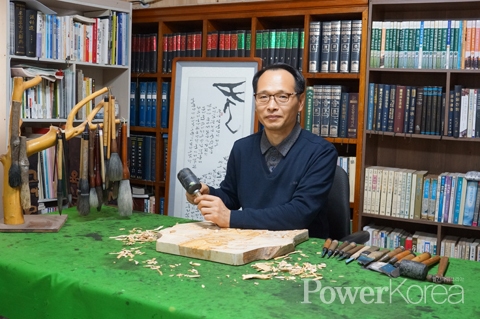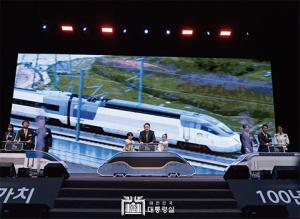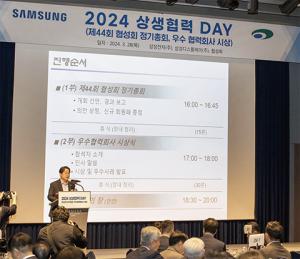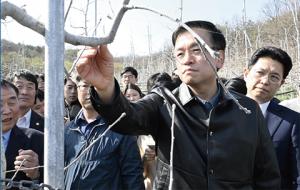 |
||
| ▲ Song Tae-jeong aka Dowon | ||
Seogak is an art carving letters and images on wood. It has a close relation to calligraphy which developed into modern seogak where many colors and fonts are applied. Seogak artist Song Tae-jeong aka Dowon is famous for his years long research on seogak in relation to calligraphy and shell-and-bone characters.
Starting the path in 1987
Song was born in Jindo County and learned calligraphy from childhood in accordance of his father’s will. He learned it under the instruction of Yoo Byeong-ri (advisor of the Korea Seogak Association) at Heungin Calligraphy Academy in Dongdaemun from 1987. It was the time where modern seogak started to be born and he learned both traditional and modern seogak techniques as a result.
After years of hard work and tireless passion, he started to make strong presence in the circle by winning a special prize at the Grand Calligraphy Exhibition of Korea, excellence prize at the Seoul Calligraphy Exhibition, and the grand prize at the Korea Professional Artist Mall Festival.
He also has served as the head judge of the Grand Art Competition of Korea, a judge of the Jeollanamdo Grand Art Exhibition, a member of the seogak department of the Korea Calligraphy Association, a board member of the Korea Seogak Association, a judge of the Grand Art Exhibition of Korea, and a board member of the Korean Fine Arts Association.
From attention to detail to perfection
Song enjoys using ‘tugak’ as a method alongside roof tile, clay, wood and rice paper as materials. Despite he learned traditional calligraphy, he values more of space and resting emphasized in modern seogak than the solid style of the tradition. Yet hard work and understanding have always been the core elements that have driven him through to be who he is today. It is Song’s principle to have attention to detail in all process to make a work with perfection.
“It is regretful that some people start coping at first, which is normal, but they still copy after years in which the time they have to find and apply their own methods and styles. Also, a good work not only requires one’s own creative thought but more of hard work and continuous research in master pieces” said Song.
Working on interpreting Chinese shell-and-bone characters
As an ardent Christian and a researcher on shell-and-bone characters, he published a series on <Chinese Shell-and-Bone Characters to See the Truth of the Bible> on a Christian newspaper in Europe that has 4,000 circulations. He also published the series on the Siloam Missionary newspaper of Jeonju City that has 7,000 circulations.
He still is working on the series and is ambitious to spread the teachings of the Bible to 1.4 billion people in China through the local missionaries by publishing the book on completing the series.
Song is the first case in the world in terms of research with referencing ancient civilizations including Sumer, the Bible and top Chinese scholars in the field in relation to shell-and-bone characters. It is notable that he has published 300 books on ancient civilizations in the world alongside a number of translations for the last 16 years.
Record about the Bible in ancient Chinese books
Song said that ancient Chinese books contain records of ancient civilizations including Sumer and the Biblical events. The problem is that Chinese scholars tend to interpret these records and the Biblical events within their own boundaries, leaving out their original meanings.
Samuel Noah Kramer, an authority of Sumer, asserts that Sumer is the race of Semitic people, the Noah’s oldest son after the Great Flood. And scholars who studied ancient civilizations said that they are all ‘a single civilization community’ derived from Sumer. In this respect, the China’s first shell-and-bone characters respond to the ancient records on clay tablets on the Great Flood, creation, corruption, sacrificial rituals and the Messiah.
Ho Hui Sun, who researched on 16,000 shell-and-bone characters, said the core characteristics of the shell-and-bone characters of Shang dynasty was ‘ritual to the God’ held in B.C 1250. For example, the Chinese character 愛 (love) is a mix of the God’s love giving hand, the Noah’s receiving hand, and the benevolent heart to save the people. For another example, 帝 (ritual) is a symbol of firewood alter to praise the Lord in heaven.
Song also asserted that Fuxi and Nuwa in China are but Adam and Eve, the Kunlun Mountains in China the Eden, and Yu the Great in China the Noah as proved by academic evidences.
Song made his own nickname ‘Dowon’ when in high school to mean to be a man like an honest potter who makes his works with such diligence and understanding so that his works also can contain deeper and wider understanding of his art world. Currently, he is preparing for a solo exhibition.
 |
안정희 기자 honesty5835@naver.com







